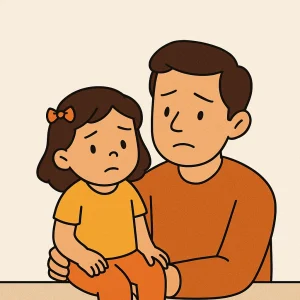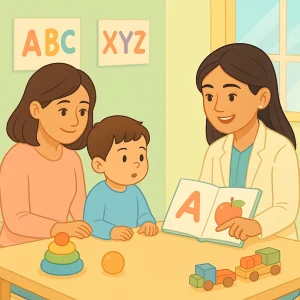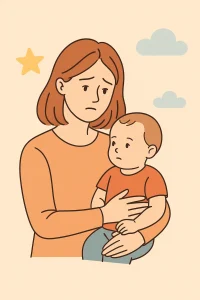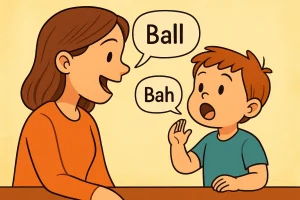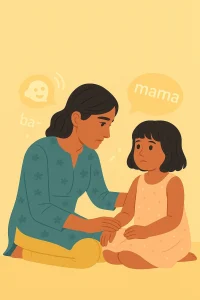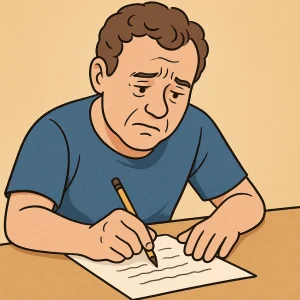Aphasia: Causes, Symptoms, Types and Treatment
By Rajini D
Last Updated: April 20, 2024
Have you or a loved one ever found yourselves grappling with the challenge of piecing words together, as if the very essence of communication has become a puzzle? This perplexing condition, known as aphasia, affects countless individuals, turning everyday conversations into a labyrinth of misunderstandings and frustrations. Unlike the more commonly discussed neurological conditions, aphasia remains under the radar for many despite its significant impact on one’s quality of life.
Imagine the brain as a network of highways, with words and sentences flowing like traffic. Aphasia occurs when there’s a disruption in this network — a roadblock, if you will, caused by damage to the areas of the brain responsible for language. This could manifest as difficulty in speaking, understanding, reading, or writing. While the thought of such a challenge might seem daunting, there’s a beacon of hope that shines brightly on the path to recovery: speech therapy.
Also read: Understanding Transcortical Sensory Aphasia
What is Aphasia?
At its core, aphasia is a communication disorder that strips away the ease of using language, a fundamental human ability that allows us to express our thoughts, feelings, and needs. It’s as though the words are right there, but no matter how hard you try, they just won’t come out right. Or perhaps they get jumbled up, leaving both you and the listener puzzled.
Aphasia typically springs from damage to the areas of the brain that govern language. This damage can occur in various ways, but most commonly, it’s the aftermath of a stroke. Just as a storm can disrupt the network of roads and highways that keep a city alive, a stroke can interrupt the neural pathways through which our language flows. Other times, the cause may be a traumatic brain injury, perhaps from an accident, or conditions like brain tumors or neurodegenerative diseases.
The impact of aphasia on daily life cannot be overstated. Imagine standing in the middle of a bustling market, unable to ask for what you need or even understand what others are saying to you. Or picture yourself surrounded by loved ones, yet feeling utterly isolated because the words to join the conversation just won’t come. It’s not just about the struggle to communicate; it’s about the frustration, the social isolation, and the loss of independence that come with it.
Also Read: Decoding the Differences: Aphasia and Apraxia Unveiled
The Faces of Aphasia
Aphasia, much like the individuals it affects, comes in various forms, each with its unique challenges and implications for communication. Understanding these variations is akin to recognizing the distinct voices in a choir, each contributing to the harmony in different ways.
Let’s explore three common types of aphasia, Broca’s, Wernicke’s, and Anomic’s, through relatable scenarios that illustrate their impact on daily communication.
Broca’s Aphasia:
- The Struggle for Words Imagine wanting to tell a friend about a movie you watched, but the words feel stuck, and what comes out is fragmented and effortful. This is a day in the life of someone with Broca’s aphasia. Here, the ability to form complete sentences is impaired, making speech seem like a laborious task. Despite understanding what’s being said by others, the individual struggles to express thoughts verbally. This form of aphasia turns simple conversations into a maze of frustration and silence.
- Scenario: Sarah, a vibrant individual with Broca’s aphasia, attempts to share her excitement about her daughter’s graduation. What she wants to say is, “My daughter graduated top of her class, and I’m so proud!” Instead, she painstakingly utters, “Daughter… school… good… happy.”
Wernicke’s Aphasia:
- Lost in Translation Now, picture yourself speaking fluently, but the words you use are jumbled, making little to no sense to the listener. For people with Wernicke’s aphasia, comprehension and the ability to produce meaningful language are significantly affected. They can speak in long sentences, but the words may be nonsensical or irrelevant, leaving listeners bewildered.
- Scenario: Raj, an avid gardener with Wernicke’s aphasia, tries to explain how to care for roses. What he intends to convey is, “Roses need plenty of sunlight and water.” However, what he says is, “Sunny water keeps the red singing.”
Anomic Aphasia:
- The Name Game Visualizes having every detail about an object in your mind but being unable to recall its name. This is the essence of Anomic aphasia, where word retrieval, especially nouns and verbs, becomes a daunting challenge. Conversations can flow until the individual hits a stumbling block, unable to name a specific object or action, which can be both perplexing and isolating.
- Scenario: Alex, a chef who loves sharing recipes, has Anomic aphasia. When trying to describe how to make spaghetti Bolognese, he says, “You need to boil the… um, the long, thin… and add the… the red sauce with meat.” The essential words “pasta” and “tomato sauce” elude him.
Also read: Anomic Aphasia: Speech Therapy Tips to Help You Speak Better
Through these scenarios, it’s clear that aphasia deeply affects not just the ability to communicate but also the confidence and social interaction of those it touches. The challenges faced by Sarah, Raj, and Alex highlight the diverse impact of aphasia types on everyday life. However, with understanding and support, individuals with aphasia can find new ways to express themselves and connect with the world around them.
Symptoms and Diagnosis
Recognizing the signs of aphasia and understanding the path to its diagnosis are crucial first steps toward navigating the journey of recovery. While aphasia manifests in various forms, certain common symptoms can serve as indicators, signaling when it might be time to seek professional advice.
Common Symptoms of Aphasia:
- Struggling to Find Words (Anomia): The frustrating feeling of a word being “on the tip of your tongue” but not being able to say it.
- Speaking in Short or Incomplete Sentences: Having the intention to speak more but only managing a few words.
- Substituting Words or Sounds: Using a different word than intended is often unrelated, which can make sentences hard to understand.
- Speaking in Sentences That Make No Logical Sense: Constructing sentences that are grammatically incorrect or nonsensical.
- Difficulty Understanding Others: Finding it hard to follow conversations or instructions.
- Problems with Reading and Writing: Challenges in reading a book or writing messages that were once straightforward.
The Diagnosis Process Simplified:
Diagnosing aphasia involves a comprehensive evaluation that looks beyond the surface symptoms to understand the depth and nature of the communication difficulties. This process typically includes:
- Initial Consultation: This involves discussing the symptoms, how they’re affecting daily life, and any recent events that might have triggered them, such as a stroke or head injury.
- Language Assessment: An SLP will conduct a series of tests designed to evaluate various aspects of language, including speaking, understanding, reading, and writing.
- Cognitive Testing: Since cognitive functions like memory and problem-solving can be intertwined with language, assessing these areas helps paint a fuller picture.
- Imaging Tests: In some cases, diagnostic imaging like MRI or CT scans may be recommended to identify any brain injuries or abnormalities that could be contributing to aphasia.
The role of the Speech-Language Pathologist is not just to diagnose but to understand the person behind the symptoms, crafting a treatment plan that aligns with their unique needs and life goals.
The Power of Speech Therapy
In the journey to overcome the challenges of aphasia, speech therapy emerges as a beacon of hope, offering more than just a series of exercises — it represents a pathway to rediscovery. Rediscovery of one’s voice, the joy of engaging in meaningful conversation, and the profound satisfaction that comes from being understood. This section delves into the transformative potential of speech therapy, showcasing it as a pivotal tool in the treatment of aphasia.
Transformative Potential of Speech Therapy
Speech therapy goes beyond mere verbal exercises; it’s an intricate process tailored to address the unique challenges faced by each individual. It harnesses a range of techniques and activities designed to restore, as much as possible, the ability to communicate effectively. For someone navigating the complexities of aphasia, this could mean relearning how to form words, improving comprehension, or finding alternative ways to express thoughts and feelings.
Diverse Therapy Options and Techniques
A speech-language pathologist (SLP) might employ a variety of strategies, each chosen for its potential to meet specific goals. Some of these include:
- Melodic Intonation Therapy (MIT): Leveraging the musical elements of speech to assist individuals who find speaking difficult. This approach can tap into the brain’s innate musicality, helping to unlock speech through melody and rhythm.
- Constraint-Induced Language Therapy (CILT): Encouraging the use of verbal language by limiting non-verbal communication modes. It’s akin to a workout for your language skills, strengthening them through practice and repetition.
- Semantic Feature Analysis (SFA): A technique aimed at improving word retrieval through association. By exploring the attributes of objects or concepts (what they do, what they look like, etc.), individuals can re-establish connections to lost words.
- Augmentative and Alternative Communication (AAC): For those who find verbal speech exceedingly challenging, AAC devices offer a bridge to expression, whether through pictures, gestures, or digital speech output.
Comparing Speech Therapy Techniques
| Technique | Focus Area | Description | Ideal For |
|---|---|---|---|
| Melodic Intonation Therapy (MIT) | Speech Production | Uses melody and rhythm to facilitate speech in those with severe expressive aphasia. | Individuals with non-fluent aphasia. |
| Constraint-Induced Therapy (CILT) | Verbal Expression | Encourages the use of spoken language by restricting other forms of communication. | People who rely heavily on non-verbal cues. |
| Semantic Feature Analysis (SFA) | Word Retrieval | Focuses on improving the ability to name objects by exploring their features and associations. | Those with difficulty finding words. |
| Augmentative and Alternative Communication (AAC) | Overall Communication | Uses devices or systems to supplement or replace speech. | Individuals with severe expressive or comprehensive aphasia. |
| Technology-aided Exercises | Speech, Reading, Writing | Incorporates apps and software for targeted practice in language skills. | Anyone comfortable with digital devices requiring flexible practice times. |
How Wellness Hub Can Support Your Journey
In the expedition to navigate through aphasia, discovering a compass that points you toward progress and understanding is invaluable. Wellness Hub stands as such a beacon, illuminating the path for those seeking quality speech therapy and support for aphasia. Our commitment extends beyond just providing services; we aim to foster a community where individuals and families touched by aphasia feel seen, heard, and supported.
A Resource for Quality Speech Therapy
At Wellness Hub, we recognize the pivotal role of speech therapy in the journey of recovery from aphasia. Our platform is meticulously designed to connect you with highly skilled speech-language pathologists (SLPs) who specialize in aphasia treatment. These professionals are not just adept at employing the latest techniques and technology in speech therapy; they are also compassionate listeners and guides who understand the emotional and psychological nuances of aphasia recovery.
Benefits of Engaging with Wellness Hub
- Personalized Care: Access to a network of specialized SLPs who can tailor speech therapy to your unique needs.
- Community Support: A platform to connect with others who understand the journey, offering mutual support and encouragement.
- Resources at Your Fingertips: Educational materials, success stories, and practical tips to enrich your understanding and coping strategies for aphasia.
- Innovation and Technology: Insights into how the latest apps and tools can be integrated into your therapy and daily communication.
Tips for Family and Caregivers
Supporting a loved one with aphasia can be a journey marked by challenges, learning, and profound compassion. As the bedrock of their support system, families and caregivers play a pivotal role in the recovery and rehabilitation process.
1. Simplify Communication, Not Content
- Speak Clearly and Slowly: Use simple sentences and speak at a measured pace to enhance understanding.
- Visual Aids and Gestures: Supplement verbal communication with pictures, gestures, or written words to aid comprehension and expression.
- Patience Is Key: Allow ample time for your loved one to respond, resisting the urge to complete sentences or correct errors.
2. Foster Independence and Participation
- Encourage Self-expression: Support attempts at conversation, whether through speech, drawing, writing, or gestures, valuing each effort equally.
- Decision Making: Involve your loved one in everyday decisions to foster a sense of autonomy and involvement.
- Tailor Activities: Engage in activities that are meaningful and enjoyable for them, adjusting for their communication abilities.
3. Create a Supportive Home Environment
- Organize the Living Space: Maintain a clutter-free, organized environment to minimize distractions and facilitate focus during communication and therapy sessions.
- Label Household Items: Use labels with both pictures and words on common items to enhance word recognition and retrieval.
- Technology and Apps: Integrate speech therapy apps and tools into daily routines to encourage practice and progress.
4. Educate and Empower
- Learn About Aphasia: Understanding aphasia’s nature, types, and impacts can demystify many challenges and improve empathy and support strategies.
- Join Support Groups: Participating in caregiver and family support groups can provide valuable insights, encouragement, and coping strategies from those on similar journeys.
5. Celebrate Small Wins
- Acknowledge Progress: Recognize and celebrate every improvement, no matter how small, to boost morale and motivation for both you and your loved one.
- Reflect on the Journey: Keep a journal or log of progress and challenges to reflect on how far you’ve come and plan future steps.
Conclusion
Navigating aphasia is tough, but knowing more about it and how speech therapy can help is the first step toward improvement. Speech therapy offers many ways to get better, showing us that with support, patience, and the right help, it’s possible to make real progress. Everyone’s journey is different, but many have found their way through the challenges of aphasia and learned to communicate better.
At Wellness Hub, we’re all about giving you the help and community support you need. Whether you’re looking for expert advice, useful tools, or just a place to share your experiences, we’re here for you. We encourage everyone affected by aphasia to check out Wellness Hub. You’re not alone, and with the right help, you can find your voice again and enjoy connecting with others.
Frequently Asked Questions:
1. What is Aphasia?
Aphasia is a communication disorder that occurs when the language parts of the brain are damaged. It can affect speech, understanding, reading, and writing. Common causes include stroke, traumatic brain injury, and other neurological conditions. Aphasia impacts each person differently, making personalized treatment plans essential.
2. Can Speech Therapy Help with Aphasia?
Yes, speech therapy is a key treatment for aphasia. It helps individuals regain communication skills and improve their quality of life. Speech-language pathologists tailor therapy to each person’s needs, using techniques like Melodic Intonation Therapy, Semantic Feature Analysis, and technology-aided exercises to enhance speech and language function.
3. How Can I Support a Loved One with Aphasia?
Supporting a loved one with aphasia involves patience, understanding, and effective communication strategies. Simplify your speech without simplifying content, use visual aids, encourage the use of all communication modes, and create a supportive home environment. Celebrating small wins and being actively involved in their therapy can also make a significant difference.
4. What Role Does Technology Play in Aphasia Therapy?
Technology plays a crucial role in modern aphasia therapy. Apps and devices designed for speech therapy can provide interactive exercises, augmentative communication options, and opportunities for practice outside of traditional therapy sessions. They are valuable tools for enhancing communication skills in individuals with aphasia.
5. Where Can I Find More Information and Support for Aphasia?
Wellness Hub offers a platform filled with resources, support, and a community for individuals with aphasia and their families. From connecting with specialized speech-language pathologists to accessing educational materials and joining support groups, Wellness Hub is dedicated to assisting you on your journey toward improved communication.
6. Are There Different Types of Aphasia?
Yes, there are several types of aphasia, including Broca’s aphasia, Wernicke’s aphasia, Anomic aphasia, and Global aphasia, among others. Each type affects communication differently, with some impacting speech production and others affecting understanding or the ability to name objects. A speech-language pathologist can help identify the type of aphasia and tailor treatment accordingly.
7. How Long Does Recovery from Aphasia Take?
Recovery time from aphasia varies widely among individuals and depends on factors such as the severity and type of aphasia, the cause of the brain injury, and the person’s overall health. While some individuals see significant improvements in the first few months after onset, others may experience a longer recovery journey. Continuous speech therapy and support can contribute to ongoing improvement.
8. Can Aphasia Improve Without Treatment?
While some individuals may experience natural improvement in their aphasia symptoms, speech therapy is strongly recommended to maximize recovery and improve communication skills. Speech therapy offers structured and personalized strategies for overcoming the specific challenges of aphasia, significantly enhancing the potential for improvement.
9. How Can I Find a Qualified Speech-Language Pathologist for Aphasia?
You can find qualified speech-language pathologists (SLPs) through professional associations, healthcare providers, or online platforms like Wellness Hub. Look for SLPs who specialize in aphasia and have experience with the specific challenges it presents. It’s also beneficial to choose a therapist who matches the individual’s personality and communication needs well.
10. Is It Possible to Fully Recover from Aphasia?
Full recovery from aphasia is possible for some individuals, particularly those with mild cases or those who receive early and intensive speech therapy. However, the extent of recovery varies. Many people with aphasia make significant improvements and learn new ways to communicate effectively, even if some challenges remain. Ongoing support and therapy are key to maximizing recovery potential.
About the Author:
Rajini Darugupally
M.Sc., Speech-Language Pathologist (9+ years of experience)
Rajini is a passionate and dedicated Speech-Language Pathologist with over 9+ years of experience, specializing in both developmental speech and language disorders in children and rehabilitation in adults. Driven by a desire to empower each individual to find their voice, Rajini brings a wealth of experience and a warm, genuine approach to therapy.
Currently, at Wellness Hub, she thrives in a team environment that values innovation, compassion, and achieving results for their clients.
Connect with Rajini to learn more about how she can help you or your loved one find their voice.
Book your Free Consultation Today
Parent/Caregiver Info:
Client’s Details:
* Error Message




